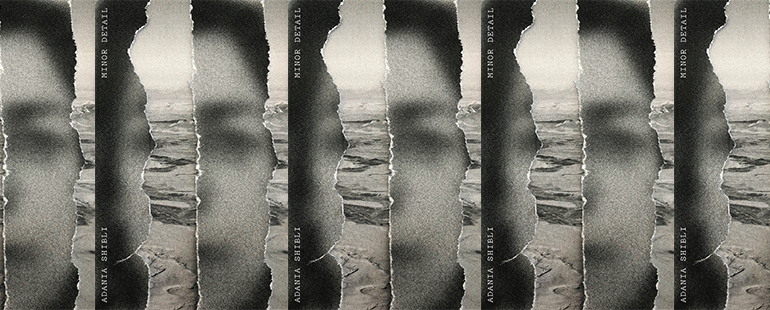Minor Detail by Adania Shibli

Minor Detail
Adania Shibli
New Directions | May 26, 2020
“Prisons,” J.M. Coetzee writes in his essay “Into the Dark Chamber,” a prescient interrogation of the representational voids typically found in novels produced under oppressive governmental regimes, “burgeon all over the face of South Africa.” Despite this ubiquity, he observes, a two-fold blindness reigns—the blindness of ubiquity itself, which buries any too-present phenomenon, and the institutional blindness produced by laws prohibiting the representation of these facilities. There’s a “particular symbolic appropriateness” to these laws, under the proscriptions of which, Coetzee explains, it’s “as though the passer-by [has] no means of confirming that what he saw—those buildings rising out of the sands in all their sprawl of gray monotony—was not a mirage or a bad dream.”
Set largely in contemporary Palestine, Adania Shibli’s new novel Minor Detail takes up similar concerns, centering on a quest for confirmation that increasingly comes to resemble the fool’s errand of attempting to pin down a mirage. With its split narrative structure that traces the rape and murder of a young Bedouin girl in 1949 in its first half, and then a young woman’s investigation of this crime in the present day in its second, the novel embodies structurally the mirage-like qualities of the past—its haziness and immateriality, and the way, depending on one’s angle of perception, it seems to assume a form one moment and slough it off the next. Heat and the evanescent shimmer of light-soaked sand rise up like a wall of static separating the book’s sections, while images and motifs flit spectrally through the haze, drawn almost magnetically to their twins on the other side.
The book opens in the Negev Desert in 1949, as a group of Israeli soldiers patrols the changeful sands for makeshift Arab settlements. Told in a procedural style redolent of the clinical detachment that typifies Coetzee’s own prose—an almost preternatural smoothness that seems to evade ideological commitment, as though the author is hiding behind the jointless armature of his prose—the first section of Minor Detail establishes Shibli’s method of resonance. When the nameless officer in charge of the patrol is bitten by an unknown insect, he sets about obsessively cleansing his quarters, crushing every bug in sight. Later, after the patrol massacres a band of Bedouins, they discover a survivor, a girl “curled up inside her black clothes like a beetle.” The connection, brief and unemphatic, draws its power from Shibli’s untrammeled narration, the steady pace of which allows her motifs to rise up naturally from the backdrop of event, suffusing the novel with a dampened sense of unease.
After washing the girl in a protracted scene—there’s a consecratory air to the proceedings, an eerie and unsettling sense that the girl is being prepared for something—the officer halfheartedly attempts to protect her from his soldiers, before raping her himself, and later shooting her. The leap between the book’s two sections becomes its own border, emblematic of the scissions and gaps that erode historical truth; the narration abruptly switches to first-person, our guide an off-kilter young woman whose mind seems to have been slued by the exigencies of life lived in divided space. “The borders imposed between things here are many, and you must absolutely must pay attention to them,” she explains, before admitting that she’s always had trouble relating to borders: “The moment I see a border I either race towards it and leap over, or cross it slyly.”
Living in occupied Palestine is a struggle that narrows her vision, focusing it on the ridiculously trivial. When a nearby building is bombed by security forces and dust flies into her office through an open window, landing on a stack of papers, she stops working, unnerved by the sediment. “I absolutely cannot stand dust, especially that kind, with its big grains that make a shuddersome sound when papers rub against each other, or when one marks on them with a pen.” The scene itself is narrated calmly, with an air of archness and deadpan detachment—you think of Buster Keaton wandering absentmindedly through a construction zone, stepping out into thin air and landing on a girder that’s just, the moment before, been hauled to his level. Shibli is a deft chronicler of the blinkering of life wrought by oppressive regimes, the way their manifold codes and proscriptions tighten around perception like a coil of barbed wire. There’s a form of survival, after all, in obsessing over the minor details of life; looking down, you find that tragedies pass fleetly overhead, like a dark cloud moving through a clear sky.
In a way, Shibli seems a hierophant of the minuscule—in her text, minor details suture the past and present together, operating on a sub rosa level that beggars historical elision. The recurrence of certain images and motifs, which calls to mind Edward Said’s exploration of the typological mindset of the exile, bridges the book’s sectional divide; the smell of petrol, for instance, used in the book’s first section to delouse the Bedouin girl, returns in the second section when the narrator spills some on herself while refilling the tank of her car. Despite our best efforts, Shibli suggests, we accrete history just like this—stumblingly—are tagged with its traces like burrs, until fate ensnares us. In the end, as the flood of convergences that ends the novel suggests, history locks onto us, barreling unerringly through time like a missile.
As a novel of traces, Minor Detail pays fitting attention to the ablated, post-Nakba landscape in which it’s set. While investigating the book’s central crime, the narrator is guided by two maps, one that shows “Palestine as it was before the year 1948,” and one that “shows streets and residential areas according to the Israeli government.” Stopping at one point to orient herself, she examines the Israeli map, which gives her route as a straight line; glancing at the Palestinian map, a sense of vertigo overtakes her as she spies the names of countless Palestinian villages stippling the territory, all absent, now, in the present day. The straightness of the path offered by the Israeli map becomes a metonym for erasure. In the face of this, Shibli’s novel seems to model a wandering historicism, proceeding from one minor detail to the next and tracing, in the process, the filiation of sorrows, or what Édouard Glissant once called “the relentless resumption of history.”


